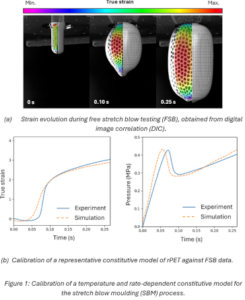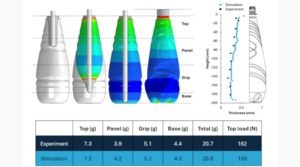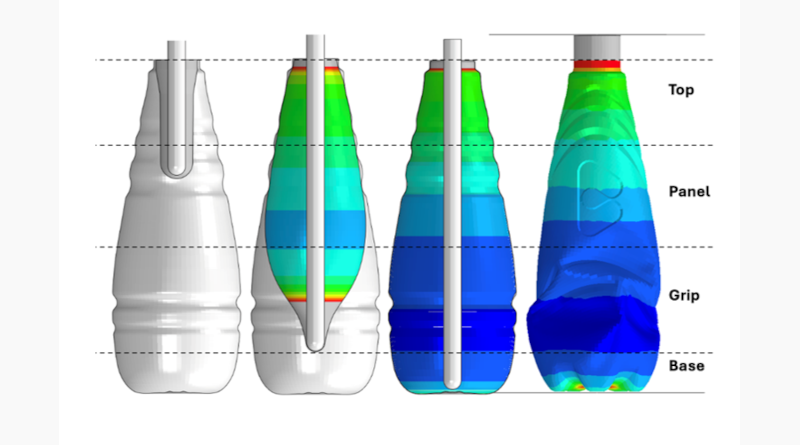Measure the shift
How digitisation is driving sustainable packaging innovation
based on an article by Reece Armstrong, CAE Graduate Engineer and Ross Blair, Head of Simulation at BMT
As global sustainability goals accelerate the shift from virgin PET to 100% recycled content (rPET), companies in the packaging sector face increasing pressure to adapt – or risk severe consequences, from supply chain vulnerabilities to regulatory penalties and market irrelevance. In response, Blow Moulding Technologies (BMT) is adopting science-based strategies to navigate these demands. By combining advanced material modelling, digital simulations, and physical testing, the company helps businesses create packaging that is high-performing and more sustainable. This data-driven approach aims to reduce waste, lower carbon footprints, and minimise risk by empowering companies to make smart decisions before moving to production.
BMT has implemented the ‘Measure, Digitise, Execute’ methodology. Where outdated trial-and-error methods once dominated, the company now integrates advanced finite element analysis (FEA) simulations with precise physical data to drive informed, confident decision-making. Rather than eliminating prototyping, BMT aims to enhance it by using smart, targeted validation to strengthen simulations. This is claimed to result in faster innovation cycles, reduced material waste, and designs that perform as intended the first time.
The process begins with ‘Measure’, conducting rigorous physical testing to capture how processing history influences material behaviour. Next, BMT ‘Digitise’ this data, transforming physical test results into precise material models. The digitisation phase is where the gap between laboratory data and industrial application is bridged. Finally, ‘Execute’ – deploying these validated digital models to optimise designs through risk-free virtual prototyping before any physical production begins. This workflow delivers transformative results, says BMT. Development cycles are accelerated, material usage optimised to the gram, and waste reduction measured in tonnes.

BMT begin by measuring what matters most – how materials behave under production-replicated conditions. Using advanced techniques like Digital Image Correlation (DIC) during Free Stretch Blow (FSB) testing and biaxial tensile methods, data is captured on how materials deform, how processing history impacts performance, and how variables such as temperature and strain rate influence behaviour. This extensive data set is then used to calibrate user-defined material models in the Abaqus simulation and analysis programme to bridge the gap between physical tests and virtual simulations. The result is a simulation that mirrors real-world material behaviour with up to 95% accuracy – a solid foundation for advanced forming and performance simulations that match reality.
Simulation meets reality
After gathering critical data to inform material models, the next step is validating that the simulations accurately predict the performance of the final product. This involves comparing the results of the forming and performance simulations against experimental data, ensuring that key attributes like mass distribution and structural integrity align with real-world conditions.

For example, when evaluating a 500 ml carbonated soft drinks (CSD) bottle (Figure 2), SBM simulations – based on the calibrated material models – have been compared with experimental data collected in BMT’s laboratory. Here, BMT performs bottle in-service testing and rapid prototyping using 3D-printed moulds. Results show simulation results closely align with the experimental data, with deviations under 5%. This validation process also extends to key metrics like thickness distribution and top load performance, confirming that the simulations accurately represent the final product’s mass distribution and strength characteristics.
A well-validated simulation boosts predictive accuracy, enabling lightweighting and optimised performance, says BMT. It reduces material waste, shortens development cycles, and delivers both environmental and commercial benefits, proving that sustainability and performance go hand in hand.
Driving the future of sustainable packaging
The adoption of digital simulations and data-driven methodologies is helping the packaging industry enhance efficiency and support sustainability goals. The shift from trial-and-error testing reduces material waste, streamlines production, and minimises carbon emissions, all while maintaining product performance. BMT’s ‘Measure, Digitise, Execute’ approach supports companies to make confident, data-backed transitions to rPET and other sustainable materials, reflecting a broader industry trend toward more environmentally conscious and technically robust packaging solutions.

